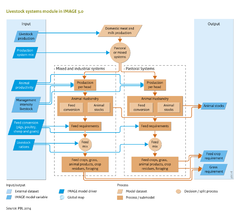Livestock systems: Difference between revisions
Jump to navigation
Jump to search
m (Text replace - "Animal stock" to "Animal stocks") |
No edit summary |
||
| Line 1: | Line 1: | ||
{{ComponentTemplate2 | {{ComponentTemplate2 | ||
|Application=Roads from Rio+20 (2012) project; Global Environmental Outlook - GEO4 project; Millennium Ecosystem Assessment project; OECD Environmental Outlook to 2030 (2008) project; OECD Environmental Outlook to 2050 (2012) project; Resource Efficiency project; Global Environmental Outlook - GEO3 project; | |Application=Roads from Rio+20 (2012) project; Global Environmental Outlook - GEO4 project; Millennium Ecosystem Assessment project; OECD Environmental Outlook to 2030 (2008) project; OECD Environmental Outlook to 2050 (2012) project; Resource Efficiency project; Global Environmental Outlook - GEO3 project; | ||
|IMAGEComponent=Scenario drivers; Agricultural economy and forestry; Agricultural systems; Agriculture and land use; Atmospheric composition and climate; Crop and grass; | |IMAGEComponent=Scenario drivers; Agricultural economy and forestry; Agricultural systems; Agriculture and land use; Atmospheric composition and climate; Crop and grass; | ||
|KeyReference=Bouwman et al., 2005; | |KeyReference=Bouwman et al., 2005; | ||
|Reference=Bruinsma, 2003; Bouwman et al., 2006; Bouwman et al., 2005; Delgado et al., 1999; Seré and Steinfeld, 1996; FAO, 2012; | |Reference=Bruinsma, 2003; Bouwman et al., 2006; Bouwman et al., 2005; Delgado et al., 1999; Seré and Steinfeld, 1996; FAO, 2012; | ||
|InputVar=Production system mix; Feed conversion; Livestock rations; Livestock production; Management intensity livestock; Animal productivity; | |InputVar=Production system mix; Feed conversion; Livestock rations; Livestock production; Management intensity livestock; Animal productivity; | ||
|OutputVar=Animal stocks; Feed crop requirement; Grass requirement; | |OutputVar=Animal stocks; Feed crop requirement; Grass requirement; | ||
|Description=Food production will have to increase in order to feed the world’s growing population. However, with increasing prosperity and falling production costs, dietary patterns are shifting to include a higher proportion of meat and milk. In the last few decades, traditional mixed farming systems have not been unable to raise production levels sufficiently to meet increasing demand. Consequently, modern livestock production systems are expanding rapidly particularly for poultry and pork, creating growing demand for crops. This trend started in high-income countries and is now observed in emerging and developing countries ([[Bruinsma, 2003]]). | |Description=Food production will have to increase in order to feed the world’s growing population. However, with increasing prosperity and falling production costs, dietary patterns are shifting to include a higher proportion of meat and milk. In the last few decades, traditional mixed farming systems have not been unable to raise production levels sufficiently to meet increasing demand. Consequently, modern livestock production systems are expanding rapidly particularly for poultry and pork, creating growing demand for crops. This trend started in high-income countries and is now observed in emerging and developing countries ([[Bruinsma, 2003]]). | ||
Revision as of 13:35, 29 April 2014
Parts of Livestock systems
| Component is implemented in: |
| Components: |
| Related IMAGE components |
| Projects/Applications |
|
| Models/Databases |
| Key publications |
| References |
Key policy issues
- What are the impacts of increasing livestock production on land use, greenhouse gases and other emissions to air and surface water?
- How does the use of marginal lands for grazing increase the risk of degradation and loss of productivity, inducing more forest clearing?
